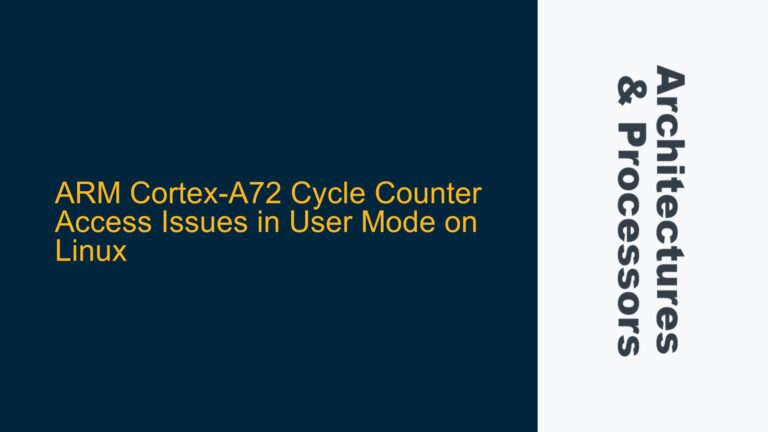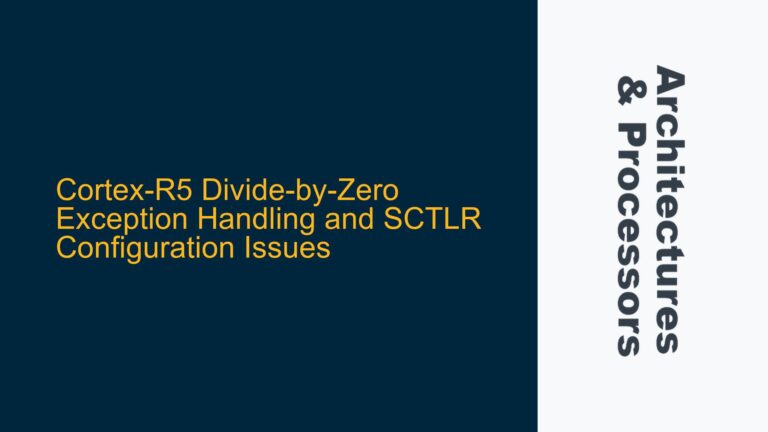Cortex-A8 NEON Pipeline Stages and Multi-Cycle Instruction Behavior
The Cortex-A8 NEON pipeline is a 10-stage pipeline designed to handle Single Instruction Multiple Data (SIMD) operations efficiently. The NEON engine is tightly integrated with the ARM core, allowing for parallel execution of scalar and vector instructions. The pipeline stages are divided into fetch, decode, issue, execute, and write-back phases, with specific stages dedicated to NEON operations. Understanding how multi-cycle instructions like VMUL (Vector Multiply) interact with the pipeline is critical for optimizing performance.
The NEON pipeline can handle multiple instructions simultaneously through a process called dual-issue. Dual-issue allows two independent instructions to be executed in parallel, provided they do not conflict in terms of resources or dependencies. However, multi-cycle instructions like VMUL complicate this process because they occupy the pipeline for multiple cycles, limiting the opportunities for dual-issue.
In the case of VMUL, which takes 4 cycles to complete, the pipeline must ensure that the instruction progresses through its stages without stalling. If two independent VMUL instructions are issued back-to-back, the second VMUL cannot start until the first VMUL has advanced sufficiently in the pipeline. This creates a scenario where the second VMUL is delayed, even though the instructions are independent. The pipeline stages for the first VMUL would be N6, N7, N8, and N9, while the second VMUL would start at N5, N6, N7, and N8, assuming no other instructions are inserted between them.
The statement "The NEON engine can potentially dual issue on both the first and last cycle of a multi-cycle instruction, but not on any of the intermediate cycles" refers to the ability of the pipeline to issue a second instruction concurrently with the start or completion of a multi-cycle instruction. For example, if a VMUL is issued at stage N6, another independent instruction can be issued at the same time (first cycle) or when the VMUL completes at stage N9 (last cycle). However, during the intermediate stages (N7 and N8), the pipeline is fully occupied by the VMUL, preventing dual-issue.
Memory Access Patterns and Instruction Pairing Constraints
One of the primary challenges in optimizing the Cortex-A8 NEON pipeline is managing memory access patterns and instruction pairing constraints. The NEON engine relies on efficient data flow between registers and memory, and any bottlenecks in this flow can significantly impact performance. Multi-cycle instructions like VMUL exacerbate this issue because they occupy the pipeline for extended periods, reducing the opportunities for overlapping memory accesses with computation.
When two VMUL instructions are issued back-to-back, the pipeline must wait for the first VMUL to complete before the second VMUL can begin. This creates a gap in the pipeline where no useful work is being done, leading to underutilization of the NEON engine. To mitigate this, developers can insert other NEON instructions between the VMUL instructions to fill the pipeline and maintain throughput. For example, a VADD (Vector Add) instruction can be issued between two VMUL instructions, allowing the pipeline to remain active while the first VMUL completes.
The NEON engine’s ability to dual-issue instructions is also constrained by the availability of functional units. The Cortex-A8 has a limited number of functional units for arithmetic, logic, and memory operations, and these units must be shared between scalar and vector instructions. If a multi-cycle instruction like VMUL is using the arithmetic unit, other instructions that require the same unit cannot be issued concurrently. This further limits the opportunities for dual-issue and increases the importance of careful instruction scheduling.
Optimizing NEON Pipeline Throughput with Data Synchronization and Instruction Reordering
To maximize the throughput of the Cortex-A8 NEON pipeline, developers must focus on data synchronization and instruction reordering. Data synchronization ensures that the pipeline has a steady supply of data to process, while instruction reordering minimizes stalls and maximizes dual-issue opportunities. These techniques are particularly important when working with multi-cycle instructions like VMUL, as they help to fill the pipeline and maintain high utilization.
One effective strategy is to interleave independent NEON instructions between multi-cycle instructions. For example, if two VMUL instructions are required, a VADD or VLD (Vector Load) instruction can be inserted between them. This allows the pipeline to remain active while the first VMUL completes, reducing the overall execution time. Additionally, developers can use data prefetching to ensure that the necessary data is available in the cache when needed, minimizing memory access latency.
Another important consideration is the use of data synchronization barriers to ensure that all pipeline stages have completed before proceeding to the next set of instructions. This is particularly important when working with multi-cycle instructions, as it prevents data hazards and ensures correct results. The Cortex-A8 provides several synchronization primitives, including the Data Synchronization Barrier (DSB) and Data Memory Barrier (DMB) instructions, which can be used to enforce ordering constraints.
Finally, developers should carefully analyze the pipeline stages and timing of their NEON code to identify potential bottlenecks. Tools like cycle-accurate simulators and performance counters can provide detailed insights into pipeline behavior, allowing developers to fine-tune their code for maximum efficiency. By understanding the intricacies of the Cortex-A8 NEON pipeline and applying these optimization techniques, developers can achieve significant performance improvements in their applications.
Detailed Breakdown of Cortex-A8 NEON Pipeline Stages
To fully understand the behavior of multi-cycle instructions like VMUL in the Cortex-A8 NEON pipeline, it is essential to break down the pipeline stages and their functions. The following table provides a detailed overview of the 10-stage pipeline:
| Stage | Name | Description |
|---|---|---|
| N1 | Fetch 1 | Instruction fetch from the instruction cache. |
| N2 | Fetch 2 | Continuation of instruction fetch. |
| N3 | Decode | Decoding of the instruction and operand fetch. |
| N4 | Issue | Instruction issue to the appropriate functional unit. |
| N5 | Execute 1 | First stage of execution for arithmetic and logic operations. |
| N6 | Execute 2 | Second stage of execution for arithmetic and logic operations. |
| N7 | Execute 3 | Third stage of execution for arithmetic and logic operations. |
| N8 | Execute 4 | Fourth stage of execution for arithmetic and logic operations. |
| N9 | Write-back 1 | First stage of write-back for results to registers. |
| N10 | Write-back 2 | Second stage of write-back for results to registers. |
In the case of a VMUL instruction, the execution stages (N5 to N8) are fully occupied for four cycles. This means that no other arithmetic or logic instructions can be issued to the same functional unit during this period. However, other functional units, such as those for memory access or scalar operations, may still be available for dual-issue.
Example of Instruction Scheduling with VMUL
Consider the following sequence of NEON instructions:
- VMUL.F32 Q0, Q1, Q2 // Vector multiply (4 cycles)
- VMUL.F32 Q3, Q4, Q5 // Vector multiply (4 cycles)
- VADD.F32 Q6, Q7, Q8 // Vector add (2 cycles)
If these instructions are issued back-to-back, the pipeline will experience stalls because the second VMUL cannot start until the first VMUL has completed. The following table illustrates the pipeline stages for this sequence:
| Cycle | N1 | N2 | N3 | N4 | N5 | N6 | N7 | N8 | N9 | N10 |
|---|---|---|---|---|---|---|---|---|---|---|
| 1 | VMUL | |||||||||
| 2 | VMUL | |||||||||
| 3 | VMUL | |||||||||
| 4 | VMUL | |||||||||
| 5 | VMUL | |||||||||
| 6 | VMUL | |||||||||
| 7 | VMUL | |||||||||
| 8 | VMUL | |||||||||
| 9 | VMUL | |||||||||
| 10 | VMUL | |||||||||
| 11 | ||||||||||
| 12 |
As shown in the table, the second VMUL cannot start until cycle 5, resulting in a gap of 4 cycles where the pipeline is underutilized. To address this, the VADD instruction can be inserted between the two VMUL instructions, as shown below:
- VMUL.F32 Q0, Q1, Q2 // Vector multiply (4 cycles)
- VADD.F32 Q6, Q7, Q8 // Vector add (2 cycles)
- VMUL.F32 Q3, Q4, Q5 // Vector multiply (4 cycles)
The updated pipeline stages are as follows:
| Cycle | N1 | N2 | N3 | N4 | N5 | N6 | N7 | N8 | N9 | N10 |
|---|---|---|---|---|---|---|---|---|---|---|
| 1 | VMUL | |||||||||
| 2 | VMUL | |||||||||
| 3 | VMUL | |||||||||
| 4 | VMUL | |||||||||
| 5 | VMUL | |||||||||
| 6 | VMUL | |||||||||
| 7 | VMUL | |||||||||
| 8 | VMUL | |||||||||
| 9 | VMUL | |||||||||
| 10 | VMUL | |||||||||
| 11 | VADD | |||||||||
| 12 | VADD | |||||||||
| 13 | VADD | |||||||||
| 14 | VADD | |||||||||
| 15 | VADD | |||||||||
| 16 | VADD | |||||||||
| 17 | VADD | |||||||||
| 18 | VADD | |||||||||
| 19 | VADD | |||||||||
| 20 | VADD |
By inserting the VADD instruction, the pipeline remains active, and the second VMUL can start earlier, reducing the overall execution time.
Conclusion
The Cortex-A8 NEON pipeline is a powerful tool for accelerating SIMD operations, but it requires careful management of multi-cycle instructions like VMUL to achieve optimal performance. By understanding the pipeline stages, memory access patterns, and instruction pairing constraints, developers can implement effective strategies for data synchronization and instruction reordering. These techniques, combined with the use of performance analysis tools, enable developers to fully leverage the capabilities of the Cortex-A8 NEON engine and deliver high-performance embedded applications.






